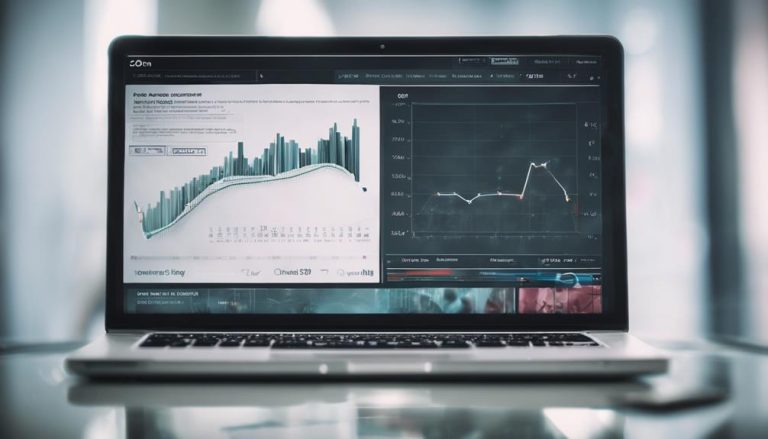Using Social Media Analytics for Data-Driven Decisions
You're likely no stranger to the importance of social media in your business strategy, but are you using it to its full potential? You're probably posting regularly, engaging with your audience, and tracking your follower count, but what about the wealth of data hiding beneath the surface? By tapping into social media analytics, you can uncover valuable insights that inform your marketing decisions, optimize your content, and drive real results. But where do you even start, and what metrics should you be tracking to get the most out of your social media efforts?
Key Takeaways
- Select the right social media analytics tools that integrate with existing data systems to ensure seamless data integration across multiple platforms.
- Track key performance indicators (KPIs) that align with business objectives, such as follower growth rate and engagement rate, to drive real results.
- Conduct sentiment analysis to examine emotions behind interactions and adjust strategy to better connect with the audience based on sentiment analysis.
- Analyze competitor social media strategies to identify gaps and opportunities, and refine your strategy to stay ahead.
Setting Up Social Media Analytics
To effectively track your online performance and make data-driven decisions, start by setting up social media analytics tools that align with your business goals and objectives.
This involves selecting the right tools that can integrate with your existing data systems, ensuring seamless data integration. You'll want to weigh tools that can track metrics across multiple social media platforms, providing an exhaustive view of your online presence.
When it comes to tool selection, don't just choose the most popular option.
Take the time to research and evaluate tools based on your specific needs. Weigh factors such as the type of data you want to track, the level of customization you need, and the scalability of the tool.
Some popular social media analytics tools include Hootsuite Insights, Sprout Social, and Google Analytics.
Identifying Key Performance Indicators
Tracking the right key performance indicators (KPIs) is crucial for measuring the success of your social media strategy, as it allows you to focus on the metrics that matter most to your business goals. To pinpoint the right KPIs, you need to examine your business objectives and the social media metrics that correspond with them. This is where metric alignment comes in – ensuring that your social media metrics are tied to your business goals.
| KPI | Business Objective |
|---|---|
| Follower growth rate | Increase brand awareness |
| Engagement rate | Drive website traffic |
| Conversion rate | Generate leads |
| Return on Ad Spend (ROAS) | Increase revenue |
When selecting KPIs, it's imperative to evaluate data quality. Are your metrics accurate and reliable? Are you tracking the right data points? By focusing on high-quality data and aligning your metrics with your business objectives, you'll be able to make data-driven decisions that drive real results.
Tracking Engagement and Sentiment
Your social media analytics are incomplete without a grasp of engagement and sentiment, which reveal how your audience interacts with your content and perceives your brand.
By tracking engagement metrics such as likes, comments, shares, and reactions, you'll gain insight into what resonates with your audience and what doesn't.
But engagement is only half the story. Sentiment analysis takes it a step further by examining the emotions behind those interactions.
Are people excited, frustrated, or indifferent to your content? Emotion tracking helps you understand the emotional tone of your audience, allowing you to adjust your strategy to better connect with them.
Analyzing Competitor Performance
By examining how your competitors fare on social media, you can pinpoint opportunities to outperform them and identify gaps in your own strategy. This process, known as social spying, allows you to gather valuable insights from their strengths and weaknesses. You can then use this information to refine your strategy and stay ahead of the competition.
Content strategy: What types of content are they posting, and how often? Are they using videos, images, or text-only posts?
Engagement rates: How are their followers interacting with their content? Are they generating more likes, comments, or shares?
Follower growth: How quickly are they gaining or losing followers? Are they experiencing a steady increase or a sudden surge?
Influencer collaborations: Are they partnering with influencers to expand their reach? If so, who are these influencers, and what's the nature of their partnership?
Uncovering Customer Insights
Analyzing your social media data can reveal a wealth of information about your customers, from their demographics and interests to their pain points and behaviors.
By digging into your social media analytics, you can create detailed customer personas that help you understand who your target audience is, what they care about, and what motivates them to engage with your brand.
For instance, you might discover that your customers are mainly young adults who are interested in sustainability and eco-friendliness.
You might also identify their pain points, such as frustration with slow shipping times or difficulty finding products that align with their values.
With this information, you can tailor your marketing efforts to address these pain points and create content that resonates with your audience.
By understanding your customers' behaviors and preferences, you can develop targeted campaigns that drive engagement and conversion.
Measuring Campaign Effectiveness
Tracking campaign metrics helps you pinpoint which strategies are driving results and which need refinement, so you can optimize your social media spend and maximize ROI. By measuring campaign effectiveness, you can identify areas of improvement and allocate your budget more efficiently.
- Conversions: Track the number of sales, sign-ups, or other desired actions generated from your social media campaigns.
- Cost Per Acquisition (CPA): Calculate the cost of acquiring one customer or conversion to determine the effectiveness of your campaigns.
- Return on Ad Spend (ROAS): Measure the revenue generated by your social media ads compared to the cost of running them.
- Ad Attribution: Analyze how your social media ads contribute to conversions and sales, and adjust your strategies accordingly.
Optimizing Content Strategy
Now that you've measured your campaign's effectiveness, it's time to optimize your content strategy by analyzing performance metrics that reveal what's working and what's not.
You'll identify top-performing posts and refine your content themes to create more engaging content that resonates with your audience.
Content Performance Metrics
By monitoring content performance metrics, you can identify which types of content resonate with your audience and adjust your strategy to maximize engagement and conversions.
This is vital in optimizing your content strategy, as it allows you to refine your approach and create a content calendar that truly resonates with your audience.
Engagement metrics track likes, comments, shares, and reactions to understand how your audience interacts with your content.
Click-through rate (CTR) measures the percentage of users who click on your content after seeing it in their feed.
Conversion rate analyzes how many users complete a desired action, such as filling out a form or making a purchase, after engaging with your content.
Cost per conversion calculates the cost of acquiring one conversion, helping you optimize your budget allocation.
Identifying Top-Performing Posts
You can refine your content strategy by identifying top-performing posts that resonate with your audience, and then amplifying those elements to maximize engagement and conversions. By analyzing your social media analytics, you can pinpoint which types of content are driving the most engagement, and use that information to inform your future content creation.
Here are some key metrics to look for when identifying top-performing posts:
| Metric | What it Measures |
|---|---|
| Post Engagement Rate | The percentage of users who engaged with your post |
| Post Reach | The number of users who viewed your post |
| Average Watch Time | The average time users spent watching your video content |
| Click-Through Rate (CTR) | The percentage of users who clicked on your link |
Refining Content Themes
One crucial step in optimizing your content strategy is to refine your content themes, ensuring they align with your top-performing posts and resonate with your target audience.
By doing so, you'll be able to create content that sparks meaningful engagement and drives conversions.
To refine your content themes, follow these steps:
Analyze your top-performing posts: Identify the common themes, topics, and formats that are resonating with your audience.
Identify gaps in your content: Determine where your content is lacking and what topics need more coverage.
Conduct competitor research: See what themes and topics your competitors are covering and how you can differentiate yourself.
Test and iterate: Continuously test new themes and formats, and refine them based on performance data.
Turning Data Into Actionable Insights
Your social media analytics tools provide a treasure trove of data, but it's up to you to transform this raw information into actionable insights that drive meaningful business decisions. To do this, you need to develop a process for turning data into insights that inform your strategy. This involves two vital steps: data storytelling and insight validation.
| Step | Description |
|---|---|
| Data Storytelling | Translate complex data into a compelling narrative that resonates with stakeholders |
| Insight Validation | Verify that your insights are accurate and reliable, using multiple data sources and methods |
| Identifying Patterns | Uncover trends and correlations in your data to inform future actions |
| Prioritizing Insights | Focus on the most critical insights that will drive the greatest impact |
| Taking Action | Develop a plan to implement changes based on your insights and track progress |
Frequently Asked Questions
Can Social Media Analytics Tools Track Data From Private or Hidden Profiles?
You can't directly track data from private or hidden profiles, but you can use profile discovery tactics to uncover public insights, and then analyze those to inform your private insights, giving you a more complete picture.
How Often Should I Refresh My Social Media Analytics Dashboard?
You should refresh your social media analytics dashboard as often as your data velocity demands, prioritizing metrics that drive business decisions, ensuring you're always on top of trends, and adjusting your strategy accordingly.
Are Social Media Analytics Accurate in Tracking User Demographics?
You're wondering if social media analytics accurately track user demographics. Honestly, it's complicated – data sampling and demographic biases can lead to inaccuracies. You'll need to weigh these limitations when interpreting your analytics.
Can I Use Social Media Analytics for Influencer Marketing Campaigns?
You can use social media analytics to optimize influencer marketing campaigns by identifying ideal influencer targeting strategies and refining campaign optimization tactics based on real-time engagement metrics and user demographics.
Do Social Media Analytics Tools Provide Real-Time Data and Alerts?
You need real-time data to stay on top of trends, and social media analytics tools got you covered! They provide real-time insights, ensuring data freshness, so you can respond promptly to changes and opportunities.
Conclusion
You've got the insights, now it's time to act.
By leveraging social media analytics, you've uncovered trends, correlations, and areas for improvement.
Don't let your data collect dust – use it to refine your strategy, optimize your content, and drive real results.
With data-driven decisions, you'll stay ahead of the competition and achieve your objectives.
It's time to turn your insights into action and watch your business thrive.







